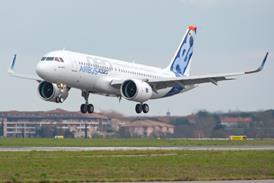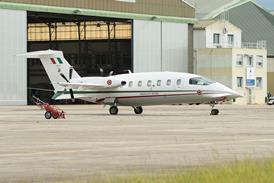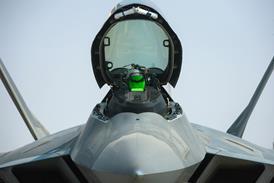GRAHAM WARWICK / WASHINGTON DC
NASA efforts to promote unmanned air vehicles as science research platforms could help remove the remaining barriers to their commercial use
NASA hopes that coffee beans and thunderstorms will excite prospective students and users about the potential scientific and commercial applications of unmanned air vehicles (UAV). Flight tests taking place this month and next in Florida and Hawaii are intended to help bridge the still-wide gap between the development of long-endurance UAVs and their exploitation as platforms for scientific research and civil applications ranging from resource monitoring to disaster management.
In Florida, NASA's General Atomics Altus II turboprop UAV is being used to investigate the life cycles of thunderstorms under the Altus cumulus electrification study (ACES) programme. Next month, NASA's AeroVironment Pathfinder Plus solar-powered UAV will be used to image coffee crops in Hawaii. Both flight trials are being conducted under NASA's UAV-based science demonstration programme.
ACES and the UAV coffee project are not NASA's only efforts to commercialise the long-endurance UAVs developed under its long-running environmental research aircraft and sensor technology (ERAST) programme. But they are among the first to include the important element of "outreach" - a concerted effort to interest the academic community and commercial entities in the potential of UAV operations. Although the flight test campaigns are relatively brief, the outreach effort will continue for two more years.
Having successfully developed a series of UAVs with unique capabilities, NASA is now focusing on demonstrating marketable applications. Late last year, a UAV was used in an experiment designed to put multi-spectral images into the hands of disaster managers in near real-time. Geo-registered images of a California wildfire, captured by an Altus UAV carrying an infrared sensor and satellite communications, were placed in the internet within 15min.
In June and July, the Pathfinder Plus was operated at the US Navy's Pacific missile range in Hawaii to demonstrate the capabilities of a solar-powered extreme-endurance UAV as a stratospheric telecommunications platform. The tests were co-funded by Japan's Communications Research Laboratory and Telecommunications Advancement Organisation and by Sky Tower, a subsidiary of UAV-developer AeroVironment that aims to develop a global telecommunications infrastructure based on solar-electric aircraft.
The Hawaii trials demonstrated digital television broadcast and the third-generation cellphone standard capable of transmitting voice, data, internet and images to mobile telephones.
Stratospheric promise
Sky Tower and Japan Stratospheric Communications, also participating in the trial, believe that UAVs orbiting over 65,000ft (20,000m) above cities, safely above air traffic and weather, will massively multiply the efficiency of existing terrestrial telecommunications and television infrastructures. Stratospheric UAVs promise to be less costly and risky to deploy than communications satellites, but major hurdles remain to be overcome before unmanned vehicles can share civil airspace with manned aircraft.
A major thrust of NASA's UAV work is to acquire the operational experience base required to develop the regulatory framework for airspace management and vehicle certification that will allow the commercial operation of UAVs. In March, Scaled Composites' Proteus long-endurance aircraft was used in flight tests in New Mexico to demonstrate "detect, see and avoid" technology that could allow UAVs to operate in civil airspace.
The Proteus was controlled from the ground, after a piloted take-off, through a series of encounters with a Boeing F/A-18 fighter, Raytheon Beech T-34C trainer and Beech Duchess business aircraft. The Proteus was equipped with a Goodrich SkyWatch HP traffic advisory system for detection of transponder-equipped aircraft and an infrared sensor and Amphitech radar for "non-co-operative" detection. Information from the sensors was downlinked to a ground controller at Las Cruces airport, who then manoeuvred the Proteus away from potential collisions.
The test illustrates NASA's approach of engaging the academic community and other partners in the development of UAV operations, as it involved New Mexico State University and the US Navy, as well as Scaled Composites and Modern Technology Solutions. Experts from the university are now assisting with the flight tests in Florida, and later in Hawaii, which involve operating UAVs in civil airspace, even if only experimentally.
The ACES programme completed its first flight on 4 August, making four passes over a storm in the Everglades. The flight lasted 3h, during which the UAV reached 50,000ft. NASA says the aircraft was able to stay in the proximity of the active thunderstorm for a total of 27min, demonstrating the capability of investigating how lightning forms and dissipates during the life cycle of a storm. Equipped to make electrical, magnetic and optical measurements of lightning activity and the electrical environment within and around thunderstorms, the Altus II is operating out of NAS Key West for the trials.
The programme is based at the National Space Science and Technology Center in Huntsville, Alabama. The centre is partnership of NASA Marshall Flight Center, Alabama universities, industry and other agencies. ACES has two primary goals: to demonstrate the utility of UAVs for investigating thunderstorms and other weather phenomena; and to demonstrate the real-time monitoring and control of a UAV science payload.
The Altus II was chosen because its low speed, long endurance and high-altitude capability allows the aircraft to stay within measurement range of the storm for extended periods.
The UAV coffee project is a collaboration between Massachusetts-based Clark University and NASA Ames Research Center, AeroVironment and Kauai Coffee, which owns the largest coffee plantation in the USA, on the Hawaiian island of Kauai. The programme aims to provide near real-time visible and infrared images of the entire 3,600 acre (1,500Ha) Kauai coffee plantation. The sensors will detect differences in coffee field ripening and allow the harvest manager to dispatch mechanical harvesters to the ripest fields.
Payload control
Operating from the Pacific missile range, which provides predictable weather for morning take-offs and evening landings of the solar-powered UAV, the Pathfinder Plus will be equipped with two high-resolution digital cameras and a wireless communication system for remote payload control and downlinking of the imagery. Up to three flights are planned, weather permitting, each lasting 14h.
The coffee project is the first endeavour by the UAV Applications Center established in May by NASA, Clark University and the Girvan Institute. Located at the NASA Research Park adjacent to NASA Ames in Moffett Field, California, the centre is chartered to conduct collaborative research and development leading to scientific and commercial use of UAVs as imaging platforms operating within civil airspace. The centre will offer educational programmes in UAV mission planning and image analysis.
Already the centre is looking to other potential applications of UAVs. One of the most promising is in monitoring wildfires, which have wrought substantial damage in the USA already this year. Homeland security is also attracting attention, and may favour solar-electric UAVs, particularly once the development of fuel-cell-based power systems allows the vehicles to remain aloft overnight and so stay on station for several days, even weeks.
Source: Flight International























